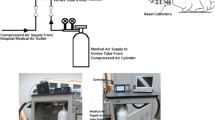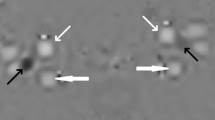Abstract
Vascular arrangements allowing a bulky transfer of venous blood from the skin of the head and from nasal and paranasal mucous membranes to the dura mater provide an excellent anatomical basis for the convection process of cooling, caused by evaporation of sweat or mucus. The dura mater, with its extraordinarily high vascularization controlled by a potent vasomotor apparatus, may transmit temperature changes to the cerebrospinal fluid (CSF) compartment. Temperature gradients of the CSF may in turn influence the temperature of brain parenchyma (1) directly, along the extensive contact area between the cerebrocortical surface and the CSF-compartment, or (2) indirectly, via brain arteries that extend over long distances and arborize within the subarachnoid space before entering the pial vascular network and brain parenchyma. Numerous subarachnoid and pial arterial branches exposed to the CSF have diameters in the range of the vessels of the retia mirabilia of animals in which selective brain cooling has been clearly established experimentally. It is also shown that the arrangements of venous plexuses within the vertebral canal provide anatomical preconditions for a cooling of the spinal cord via the CSF. The possibility of spinal cord and spinal ganglia cooling by temperature convection via venous blood — cooled in the venous networks of the skin of the backflowing through numerous anastomoses to the external and internal vertebral plexuses and, finally, into the vascular bed of the spinal dura is discussed on the basis of anatomical facts.
Similar content being viewed by others
References
Alcolado R, Weller RO, Parrish EP, Garrod D (1988) The cranial arachnoid and pia mater in man: anatomical and ultrastructural observations. Neuropathol Appl Neurobiol 14:1–17
Amenta F, Snacesario G, Ferrante F, Cavallotti C (1980) Acetyl- cholinesterase-containing nerve fibers in the dura mater of guinea pig, mouse and rat. J Neural Transm 47:237–242
Andres KH (1967) Über die Feinstruktur der Arachnoidea und Dura mater von Mammalia. Z Zellforsch 79:272–295
Andres KH, Duering MV, Muszynski K, Schmidt RF (1987) Nerve fibers and their terminals of the dura mater encephali of the rat. Anat Embryol 175:289–301
Baker MA (1979) A brain cooling system in mammals. Sci Am 240:114–122
Baker MA (1982) Brain cooling in endotherms in heat and exercise. Annu Rev Physiol 44:85–96
Batson OV (1957) The vertebral vein system. Am J Roentgenol 78:195–212
Brengelmann GL (1987) Dilemma of body temperature measurement. In: Shiraki K, Yousef MK (eds) Man in stressful environments, thermal and work physiology. Thomas, Springfield, Ill, pp 5–22
Brinnel H, Cabanac M, Hales JRS (1987) Critical upper level of body temperature, tissue thermosensitivity and selective brain cooling in hyperthermia. In: Hales JRS, Richards DAB (eds) Heat stress, physical exertion and environment. Elsevier, Amsterdam, pp 209–240
Butler AB, Douglas Mann J, Maffeo CH, Dacey RG, Jr, Johnson RN, Bass NH (1983) Mechanisms of cerebrospinal fluid absorption in normal and pathologically altered arachnoid villi. In: Wood JH (ed) Neurobiol cerebrospinal fluid. Plenum Press, New York London
Cabanac M (1993) Selective brain cooling in humans: “fancy” or fact? FASEB J 7:1143–1146
Cabanac M, Brinnel H (1985) Blood-flow in the emissary veins of the human head during hyperthermia. Eur J Appl Physiol 54:172–176
Caputa M, Perrin G, Cabanac M (1978) Ecoulement sanguin reversible dans la veine ophthalmique: mécanisme de refroidissement sélectif du cerveau humain. C R Acad Sci 87D: 1011–1014
Cloyd MW, Low FN (1974) Scanning electron microscopy of the subarachnoid space in the dog. I. Spinal cord levels. J Comp Neurol 153:325–368
Deklunder G, Dauzat M, Lecroart JL, Hauser JJ, Houdas Y (1991) Influence of ventilation of the face on thermoregulation in man during hyper- and hypothermia. Eur J Appl Physiol 62: 342–348
Dijk DJ, Landolt HP, Moser S, Wieser HG, Borbély AA (1994) Brain temperature recorded at the parahippocampal gyrus exhibits a 24-h rhythm in humans abstract. Eurosleep '94. 12th Congress of the European Sleep Research Society, Firenze, 22–27 May
Dimitridaou V, Buzzi MG, Moskowitz MA, Theoharides TC (1991) Trigeminal sensory fiber stimulation induces morphological changes reflecting secretion in rat dura mater mast cells. Neuroscience 44:97–112
Düring VM, Bauersachs M, Böhmer B, Veh RW, Andres KH (1990) Neuropeptide Y- and substance P-like immunoreactive nerve fibers in the rat dura mater encephali. Anat Embryol 182:363–373
Edvinsson L, Uddman R (1981) Adrenergic, cholinergic and peptidergic nerve fibers in dura mater — involvement in headache? Cephalalgia 1:175–179
Edvinsson L, Emson P, McCulloch J, Tatemotot K, Uddman R (1983) Neuropeptide Y: cerebrovascular innervation and vasomotor effects in the cat. Neurosci Lett 43:79–84
Edvinsson L, Brodin E, Jansen I, Uddman R (1988) Neurokinin A in cerebral vessels: characterization, localization and effects in vitro. Regul Pept 20:181–197
Elias H, Schwartz D (1971) Cerebrocortical surface areas, volumes, lengths of gyri and their interdependence in mammals, including man. Z Saeugetierkd 36:147–163
Faraci FM, Kadel KA, Heistad DD (1989) Vascular responses of dura mater. Am J Physiol 257:H157-H161
Furness JB, Papka RE, Della NG, Costa M, Eskay RL (1982) Substance P-like immunoreactivity in nerves associated with the vascular system of guinea-pigs. Neuroscience 7:447–459
Gisel A (1958) Ueber die Emissaria parietalia et mastoidea des menschlichen Schädels. Hyrtl-Almanach I:73–122
Haines DE, Frederickson RG (1991) The meninges. In: Al-Mefty O (ed) Meningiomas. Raven Press, New York, pp 9–24
Haines DE (1991) On the question of a subdural space. Anat Rec 230:3–21
Hayward JN, Baker MA (1969) A comparative study of the role of the cerebral arterial blood in the regulation of brain temperature in five mammals. Brain Res 16:417–440
Hirashita M, Shido O, Tanabe M (1992) Blood flow through the ophthalmic veins during exercise in humans. Eur J Appl Physiol 64:92–97
Jessen C, Kuhnen G (1992) No evidence for brain stem cooling during face fanning in humans. J Appl Physiol 72:664–669
Keller JT, Marfurt CF (1991) Peptidergic and serotoninergic innervation of the rat dura mater. J Comp Neurol 309:515–534
Kerber CW, Newton TH (1973) The macro and microvasculature of the dura mater. Neuroradiology 6:175–179
Klika E (1967) The ultrastructure of meninges in vertebrates. Acta Univ Carol [Med] (Praha) 13:53–71
Knyihar-Scillik E, Tajti J, Mohtasham S, Sari G, Vecsei L (1995) Electrical stimulation of the Gasserian ganglion induces structural alterations of calcitonin gene-related peptide-immunoreactive perivascular sensory nerve terminals in the rat cerebral dura mater: a possible model of migraine headache. Neurosci Lett 184:189–192
Krahn V (1982) The pia mater at the site of the entry of blood vessels into the central nervous system. Anat Embryol 164: 257–263
Krisch B (1988) Ultrastructure of the meninges at the site of penetration of veins through the dura mater, with particular reference to Pacchionian granulations. Cell Tissue Res 251:621–631
Krisch B, Leonhardt H, Oksche A (1983) The meningeal compartments of the median eminence and the cortex. Cell Tissue Res 228:597–640
Krisch B, Leonhardt H, Oksche A (1984) Compartments and perivascular arrangement of the meninges covering the cerebral cortex of the rat. Cell Tissue Res 238:459–474
Kuhnen G, Jessen C (1994) Thermal signals in control of selective brain cooling. Am J Physiol 267 R:355–359
Landolt HP, Moser S, Wiesen HG, Borbeley AA, Dijk DJ (1995) Intracranial temperature across 24 hour sleep wake cycles in humans. Neuroreport 6:913–917
Mayberg M, Zervas NT, Moskowitz MA (1984) Trigeminal projections to supratentorial, pial and dural blood vessels in cats demonstrated by horseradish peroxidase histochemistry. J Comp Neurol 233:46–56
Nabeshima S, Reese TS, Laudis DMD, Brightman MW (1975) Junctions in the meninges and marginal glia. J Comp Neurol 164:127–170
Nielson B (1988) Natural cooling of the brain during outdoor bicycling? Pflügers Arch 411:456–461
Numely SA, Nelson DA (1992) Human head cooling: mechanism and modeling. In: Lotens WA, Havenith G (eds) Proceedings of the Fifth International Conference on Environmental Ergonomics. TNO Inst Soesterburg, The Netherlands, p 134
Orlin JR, Osen KK, Hovig T (1991) Subdural compartment in pig: a morphologic study with blood and horseradish perioxidase infused subdurally. Anat Rec 230:22–37
Roland J, Bernard C, Bracard S, Czorny A, Floquet J, Race JM, Forlodou P, Picard L (1987) Microvascularization of the intracranial dura mater. Surg Radiol Anat 9:43–49
Schachenmayr W, Friede RL (1978) The origin of subdural neomembranes. Am J Pathol 92:53–62
Silverman J, Kruger L (1989) Calcitonin-gene-related-peptide immunoreactive innervation of the rat head with emphasis on specialized sensory structures. J Comp Neurol 280:303–330
Simoens P, Lauwers H, De Geest JP, De Schaepdrijver L (1987) Functional morphology of the cranial retia mirabilia in the domestic mammals. Schweiz Arch Tierheilkd 129:295–307
Steinmann WF (1984) Makroskopische Präparationsmethoden in der Medizin. Thieme, Stuttgart
Stöhr PJ (1928) Die peripherischen Anteile des vegetativen Nervensystems. Handbuch der mikroskopischen Anatomie des Menschen, vol 4. Springer, Berlin, pp 265–447
Suzuki N, Hardebo JE, Owman C (1988) Origin and pathways of cerebrovascular vasoactive intestinal polypeptide-positive nerves in rat. J Cereb Blood Flow Metab 8:697–712
Suzuki N, Hardebo JE, Owman C (1989) Origins and pathways of cerebrovascular nerves storing substance P and calcitonin gene-related peptide in rat. Neuroscience 2:427–438
Wenger CB (1987) More comments on “Keeping a cool head”. News Pharamcol Sci 2:150
Whitby JD, Dunkin LJ (1971) Cerebral, oesophageal and nasopharyngeal temperatures. Br J Anaesth 43:673–676
Zenker W, Rinne B, Bankoul S, Le Hir M, Kaissling B (1992) 5′-Nucleotidase in spinal meningeal compartments in the rat — an immuno- and enzyme histochemical study. Histochemistry 98:135–139
Zenker W, Bankoul S, Braun JS (1994) Morphological indications for considerable diffuse reabsorption of cerebrospinal fluid in spinal meninges particularly in the areas of meningeal funnels. An electronmicroscopical study including tracing experiments in rats. Anat Embryol 189:243–258
Author information
Authors and Affiliations
Rights and permissions
About this article
Cite this article
Zenker, W., Kubik, S. Brain cooling in humans — anatomical considerations. Anat Embryol 193, 1–13 (1996). https://doi.org/10.1007/BF00186829
Accepted:
Issue Date:
DOI: https://doi.org/10.1007/BF00186829




